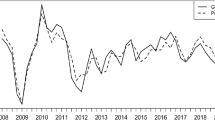Abstract
This paper estimates a dynamic factor model (DFM) for nowcasting Canadian gross domestic product. The model is estimated with a mix of soft and hard indicators, and it features a high share of international data. The model is then used to generate nowcasts, predictions of the recent past and current state of the economy. In a pseudo-real-time setting, we show that the DFM outperforms univariate benchmarks, as well as other commonly used nowcasting models, such as MIDAS and bridge regressions.





Similar content being viewed by others
Notes
Canadian monthly real GDP is compiled on a by-industry basis and industrial production is an aggregation of mining, quarrying and oil and gas extraction, utilities, manufacturing, and waste management services.
Taxes and subsidies such as sales taxes, fuel taxes, duties, and taxes on imports excise taxes on tobacco and alcohol products and subsidies paid on agricultural commodities, transportation services, and energy.
See Martin (2004) for a detailed exposition of the Bank of Canada Business Outlook Survey.
Lahiri and Monokroussos (2013) show US PMI is a useful leading indicator for economic activity.
Specifically, the importance of US variables for forecasting and nowcasting.
This result is shared with Bragoli and Modugno (2016), who also find that US variables lead to the highest improvements in accuracy earlier in the nowcasting quarter.
We also combine the models with inverse MSE weights. These results are shown in an online appendix and are very similar to the equal weights.
References
Aastveit KA, Gerdrup KR, Jore AS, Thorsrud LA (2011) Nowcasting GDP in real-time: a density combination approach. Technical report, Norges Bank
Alvarez RMC, Perez-Quiros G (2016) Aggregate versus disaggregate information in dynamic factor models. Int J Forecast 32:680–694
Baffigi A, Golinelli R, Parigi G (2004) Bridge models to forecast the euro area GDP. Int J Forecast 20:447–460
Banbura M, Giannone D, Reichlin L (2011) Nowcasting. In: Clements M P, Hendry D F (eds) The Oxford handbook of economic forecasting. Oxford University Press, Oxford, pp 63–90
Bańbura M, Modugno M (2014) Maximum likelihood estimation of factor models on datasets with arbitrary pattern of missing data. J Appl Econom 29:133–160
Barhoumi K, Darné O, Ferrara L (2010) Are disaggregate data useful for factor analysis in forecasting French GDP? J Forecast 29:132–144
Binette A, Chang J (2013) CSI: a model for tracking short-term growth in Canadian real GDP. Bank Can Rev 2013:3–12
Bork L (2009) Estimating US monetary policy shocks using a factor-augmented vector autoregression: an EM algorithm approach. CREATES Res Pap 11
Bork L, Dewachter H and Houssa R (2009) Identification of macroeconomic factors in large panels. CREATES Res Pap 43
Bragoli D, Modugno M (2016) A nowcasting model for Canada: Do US variables matter? Finance and Economics Discussion Series 036, Federal Reserve Board
Bragoli D, Metelli Luca, Modugno M (2015) The importance of updating: evidence from a Brazilian nowcasting model. OECD J: J Bus Cycle Measurement Anal 2015:5–22
Camacho M, Perez-Quiros G (2010) Introducing the euro-sting: short-term indicator of euro area growth. J Appl Econom 25:663–694
Clements MP, Galvão AB (2008) Macroeconomic forecasting with mixed-frequency data: forecasting output growth in the United States. J Bus Econ Stat 26:546–554
D’Agostino A, McQuinn K, OBrien D (2013) Nowcasting Irish GDP. OECD J: J Bus Cycle Measurement Anal 2012:21–31
Dahlhaus T, Guénette J-D and Vasishtha G (2015) Nowcasting BRIC+ M in real time. Technical report, Bank of Canada working paper
Diebold FX, Mariano RS (1995) Comparing predictive accuracy. J Bus Econ Stat 13:253–263
Doz C, Giannone D, Reichlin L (2012) A quasi-maximum likelihood approach for large, approximate dynamic factor models. Rev Econ Stat 94:1014–1024
Galbraith J, Tkacz G (2013) Nowcasting GDP: electronic payments, data vintages and the timing of data releases
Ghysels E, Santa-Clara P, Valkanov R (2006) Predicting volatility: getting the most out of return data sampled at different frequencies. J Econom 131:59–95
Ghysels E, Sinko A, Valkanov R (2007) MIDAS regressions: further results and new directions. Econom Rev 26:53–90
Giannone D, Agrippino SM and Modugno M (2013) Nowcasting China real GDP. Working paper
Giannone D, Reichlin L, Small D (2008) Nowcasting: the real-time informational content of macroeconomic data. J Monet Econ 55:665–676
Golinelli R, Parigi G (2007) The use of monthly indicators to forecast quarterly GDP in the short run: an application to the G7 countries. J Forecast 26:77–94
Lahiri K, Monokroussos G (2013) Nowcasting US GDP: the role of ISM business surveys. Int J Forecast 29:644–658
Lahiri K, Monokroussos G, Zhao Y (2015) Forecasting consumption: the role of consumer confidence in real time with many predictors. J Appl Econom
Luciani M, Pundit M, Ramayandi A, Veronese G et al (2015) Nowcasting Indonesia. Technical report, Board of Governors of the Federal Reserve System (US)
Luciani M, Ricci L (2014) Nowcasting Norway. Int J Cent Bank 10(4):215–248
Mariano R S, Murasawa Y (2003) A new coincident index of business cycles based on monthly and quarterly series. J Appl Econom 18:427–443
Martin M (2004) The Bank of Canada’s business outlook survey. Bank Can Rev 2004:3–18
Matheson TD (2010) An analysis of the informational content of New Zealand data releases: the importance of business opinion surveys. Econ Model 27:304–314
Pichette L, Rennison L (2011) Extracting information from the business outlook survey: a principal-component approach. Bank Can Rev 2011:21–28
Author information
Authors and Affiliations
Corresponding author
Additional information
The authors are extremely thankful for Haeyeon Lee for excellent research assistance. We would also like to thank seminar participants at the Bank of Canada, the 2016 Canadian Economic Association meeting, as well as comments from Andre Binette, Tatjana Dahlhaus, Domenico Giannone, Daniel de Munnik, and two anonymous referees. The views expressed in this paper are solely those of the authors. No responsibility for them should be attributed to the Bank of Canada.
Rights and permissions
About this article
Cite this article
Chernis, T., Sekkel, R. A dynamic factor model for nowcasting Canadian GDP growth. Empir Econ 53, 217–234 (2017). https://doi.org/10.1007/s00181-017-1254-1
Received:
Accepted:
Published:
Issue Date:
DOI: https://doi.org/10.1007/s00181-017-1254-1




